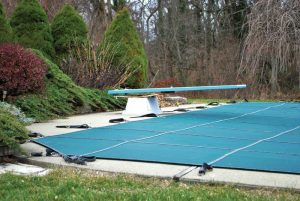
Physical winterization
There are two categories of winterization that occur when closing a pool: physical and chemical. Physically winterizing a pool focuses on protecting pool equipment and surfaces from damage due to freezing. It also focuses on keeping dirt and debris out of the pool when the water is not circulating. The amount of physical winterization that must be done to protect a pool depends on the environment and the expected weather over the course of winter. In warmer climates, physically winterizing pumps, filters, and other equipment is often not necessary due to warmer temperatures in the off-season. However, unprecedented temperatures can occur as well, take Texas for example, where recently many pool owners were caught off guard with an unexpected freeze. In colder climates or if there is a risk of a deep freeze, steps should be taken to protect pumps, filters, and plumbing from freezing.
In colder climates, lowering the water level in the pool is recommended to help prevent damage from freezing water. The recommended level is usually below the skimmer opening or at a level advised by the pool’s manufacturer or builder. Freezing water can cause equipment, pipes, and fittings to crack, leading to costly repairs. It is recommended to blow out the lines once the water level has been lowered to protect against breakage. The addition of a skimmer plug can also help protect the skimmer from being damaged by freezing temperatures.
Regardless of the climate, covering the pool is an important part of off-season pool care. The pool will go long periods of time with no use, and most pool owners stop paying attention to maintenance activities such as brushing, skimming, and vacuuming in the off-season. Dirt and debris will form over the course of winter and covering the pool will reduce the need for these activities.
As winter progresses, keep excess water and debris cleaned off the top of the cover. If water and debris get too heavy, the cover can be pulled into the pool. This can damage the pool itself, and further create a big mess to clean up when the debris from the cover ends up in the pool too. In spring, when removing the winter cover, be careful not to allow dirt, debris, and contaminants on top of the cover to fall into the pool. This can create problems with filtration, water clarity, and chlorine demand, as well as other issues.
Chemical winterization
When chemically winterizing a pool, it is imperative to treat and remove all existing problems before closing. Closing a pool with issues will lead to problems getting worse over the course of winter, causing additional time and chemicals during spring opening.






